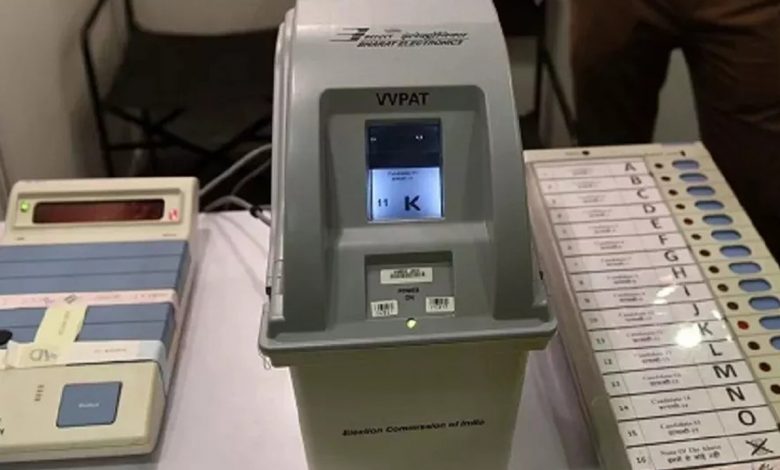Daily Current Affairs for UPSC
New Remote Electronic Voting Machine (RVM)
Topic- Government Policies and Interventions [GS Paper-2]

Context- Recently, ECI proposed a new Remote Electronic Voting Machine (RVM) that would allow domestic migrants to vote in national and regional elections.
Key Highlights
RVM
- The Remote Electronic Voting Machine (RVM) is the proposed new voting system in India which would allow domestic migrants to vote in national and regional elections.
- The RVM is developed by the Election Commission of India (ECI)
- These are similar to the existing EVMs in terms of security system and voting experience.
- RVMs can handle multiple constituencies (up to 72) from a single remote polling booth.
- Instead of a fixed ballot paper sheet, the RVM has been modified to have an electronic dynamic ballot display which will present different candidate lists corresponding to the constituency number of the voter read by a constituency card reader.
- An additional digital public display unit or a monitor to act as an interface between the constituency card reader and the Ballet Unit(BU) display.
- The electronic ballot will be prepared by the Returning Officers (ROs) of home constituencies of voters, and forwarded to the remote RO for uploading in the Symbol Loading Unit(SLU).
- The ECI has, however, not yet demonstrated a prototype of the RVM.
- EVMs in India
- About:
- Electronic Voting Machines (EVMs) are a system of voting used in India for national and regional elections
- EVMs have been in use in India on a larger scale since 1992, with the latest version being the M3 model, which has been in use since 2013
- In 2010, multiple political parties approached the ECI to develop a mechanism to verify that EVMs recorded votes correctly, leading to the development of the Voter Verified Paper Trail Audit (VVPAT) machine, that has been in use since mid-2017
Working of EVM:
- The current EVM setup includes a Balloting Unit (BU) and a VVPAT printer, both inside the voting compartment, and a Control Unit (CU) with the Presiding Officer (PO) which totals the number of votes cast.
- The VVPAT is connected to the Control Unit (CU), that sits with the Presiding Officer (PO) and totals the number of votes cast, on its display board
- The VVPAT, that is essentially a printing machine, prints a slip with the poll symbol and candidate name, once the voter presses the key on the BU.
- The slip is visible to the voter on the VVPAT’s glass screen for seven seconds after which it gets dropped off in a box inside the VVPAT.
- The use of VVPATs has become universal in elections since mid-2017.
Advantages of EVMs
- EVMs have significantly reduced the cases of booth capturing, electoral malpractice, and rigging
- They have resulted to a faster counting process as they eliminate the need for manual counting of votes and thus reduces the possibility of human error
- EVMs are tamper-proof and they prevent the manipulation of vote counts
- It allows for faster and more significant transmission of election results.
- They eliminate the need for paper ballots which can save resources and reduce the total amount of waste generated.
- They are more accessible for people with disabilities or older citizens and reduce the barrier for these groups in order to participate in the electoral process.
- These have been credited for increasing voter turnout in maximum areas.
- These are more secure than paper ballots as they eliminate the possibility of voter fraud
- EVMs with VVPAT (Voter Verified Paper Audit Trail) allows for a paper trail of the vote that ensures transparency and improves the credibility of the election.
Issues associated
- The lack of transparency in the design, prototype, software, and the hardware of EVMs.
- The EVMs are available only for black-box analysis and not accessible for technical and independent review,thus raising doubts and mistrust among citizens in the electoral process.
- The mandatory requirement of reliable electricity and power supply to operate EVMs.
- The need for proper maintenance and security of EVMs in order to ensure they are not tampered with or damaged before or during an election.
- The cost of purchasing and maintaining EVMs can be high, which can be a burden for some countries with limited financial resources.
- The possibility of power outages, network failures, or other technical problems during voting.
- The need for a robust system of voter education as well as voter awareness of their rights and responsibilities as voters.
- The lack of accessibility for citizens who are not literate or who are visually impaired.
Way Forward
- RVM is a great decision in the right direction to address particular issues of accessibility and convenience for domestic migrants who may not be able to physically travel to their voting location.
- However, there is also a need to address the logistical and administrative challenges of remote voting, and thus, ECI should work to restore trust in the electoral system” and address fears of the misuse of existing EVMs.





.png)



